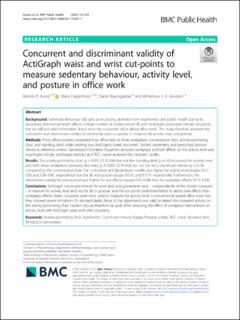Please use this identifier to cite or link to this item:
https://doi.org/10.21256/zhaw-25902Full metadata record
| DC Field | Value | Language |
|---|---|---|
| dc.contributor.author | Kuster, Roman P. | - |
| dc.contributor.author | Hagströmer, Maria | - |
| dc.contributor.author | Baumgartner, Daniel | - |
| dc.contributor.author | Grooten, Wilhelmus J. A. | - |
| dc.date.accessioned | 2022-10-28T13:31:20Z | - |
| dc.date.available | 2022-10-28T13:31:20Z | - |
| dc.date.issued | 2021 | - |
| dc.identifier.issn | 1471-2458 | de_CH |
| dc.identifier.uri | https://digitalcollection.zhaw.ch/handle/11475/25902 | - |
| dc.description.abstract | Background: Sedentary Behaviour (SB) gets an increasing attention from ergonomics and public health due to its associated detrimental health effects. A large number of studies record SB with ActiGraph counts-per-minute cut-points, but we still lack valid information about what the cut-points tell us about office work. This study therefore analysed the concurrent and discriminant validity of commonly used cut-points to measure SB, activity level, and posture. Methods: Thirty office workers completed four office tasks at three workplaces (conventional chair, activity-promoting chair, and standing desk) while wearing two ActiGraphs (waist and wrist). Indirect calorimetry and prescribed posture served as reference criteria. Generalized Estimation Equations analysed workplace and task effects on the activity level and counts-per-minute, and kappa statistics and ROC curves analysed the cut-point validity. Results: The activity-promoting chair (p < 0.001, ES ≥ 0.66) but not the standing desk (p = 1.0) increased the activity level, and both these workplaces increased the waist (p ≤ 0.003, ES ≥ 0.63) but not the wrist counts-per-minute (p = 0.74) compared to the conventional chair. The concurrent and discriminant validity was higher for activity level (kappa: 0.52–0.56 and 0.38–0.45, respectively) than for SB and posture (kappa ≤0.35 and ≤ 0.19, respectively). Furthermore, the discriminant validity for activity level was higher for task effects (kappa: 0.42–0.48) than for workplace effects (0.13–0.24). Conclusions: ActiGraph counts-per-minute for waist and wrist placement were – independently of the chosen cut-point – a measure for activity level and not for SB or posture, and the cut-points performed better to detect task effects than workplace effects. Waist cut-points were most valid to measure the activity level in conventional seated office work, but they showed severe limitations for sit-stand desks. None of the placements was valid to detect the increased activity on the activity-promoting chair. Caution should therefore be paid when analysing the effect of workplace interventions on activity level with ActiGraph waist and wrist cut-points. | de_CH |
| dc.language.iso | en | de_CH |
| dc.publisher | BioMed Central | de_CH |
| dc.relation.ispartof | BMC Public Health | de_CH |
| dc.rights | http://creativecommons.org/licenses/by/4.0/ | de_CH |
| dc.subject | Activity-promoting chair | de_CH |
| dc.subject | Agreement | de_CH |
| dc.subject | Counts-per-minute | de_CH |
| dc.subject | Kappa | de_CH |
| dc.subject | Physical activity | de_CH |
| dc.subject | ROC curve | de_CH |
| dc.subject | Sit-stand desk | de_CH |
| dc.subject | Workplace intervention | de_CH |
| dc.subject.ddc | 331: Arbeitsökonomie | de_CH |
| dc.subject.ddc | 613: Persönliche Gesundheit | de_CH |
| dc.title | Concurrent and discriminant validity of ActiGraph waist and wrist cut-points to measure sedentary behaviour, activity level, and posture in office work | de_CH |
| dc.type | Beitrag in wissenschaftlicher Zeitschrift | de_CH |
| dcterms.type | Text | de_CH |
| zhaw.departement | School of Engineering | de_CH |
| zhaw.organisationalunit | Institut für Mechanische Systeme (IMES) | de_CH |
| dc.identifier.doi | 10.1186/s12889-021-10387-7 | de_CH |
| dc.identifier.doi | 10.21256/zhaw-25902 | - |
| dc.identifier.pmid | 33579254 | de_CH |
| zhaw.funding.eu | No | de_CH |
| zhaw.issue | 345 | de_CH |
| zhaw.originated.zhaw | Yes | de_CH |
| zhaw.publication.status | publishedVersion | de_CH |
| zhaw.volume | 21 | de_CH |
| zhaw.publication.review | Peer review (Publikation) | de_CH |
| zhaw.funding.snf | 187637 | de_CH |
| zhaw.author.additional | No | de_CH |
| zhaw.display.portrait | Yes | de_CH |
| Appears in collections: | Publikationen School of Engineering | |
Files in This Item:
| File | Description | Size | Format | |
|---|---|---|---|---|
| 2021_Kuster-etal_Concurrent-discriminant-validity-actigraph-waist-wrist-cut-points-office-work.pdf | 2.02 MB | Adobe PDF |  View/Open |
Show simple item record
Kuster, R. P., Hagströmer, M., Baumgartner, D., & Grooten, W. J. A. (2021). Concurrent and discriminant validity of ActiGraph waist and wrist cut-points to measure sedentary behaviour, activity level, and posture in office work. BMC Public Health, 21(345). https://doi.org/10.1186/s12889-021-10387-7
Kuster, R.P. et al. (2021) ‘Concurrent and discriminant validity of ActiGraph waist and wrist cut-points to measure sedentary behaviour, activity level, and posture in office work’, BMC Public Health, 21(345). Available at: https://doi.org/10.1186/s12889-021-10387-7.
R. P. Kuster, M. Hagströmer, D. Baumgartner, and W. J. A. Grooten, “Concurrent and discriminant validity of ActiGraph waist and wrist cut-points to measure sedentary behaviour, activity level, and posture in office work,” BMC Public Health, vol. 21, no. 345, 2021, doi: 10.1186/s12889-021-10387-7.
KUSTER, Roman P., Maria HAGSTRÖMER, Daniel BAUMGARTNER und Wilhelmus J. A. GROOTEN, 2021. Concurrent and discriminant validity of ActiGraph waist and wrist cut-points to measure sedentary behaviour, activity level, and posture in office work. BMC Public Health. 2021. Bd. 21, Nr. 345. DOI 10.1186/s12889-021-10387-7
Kuster, Roman P., Maria Hagströmer, Daniel Baumgartner, and Wilhelmus J. A. Grooten. 2021. “Concurrent and Discriminant Validity of ActiGraph Waist and Wrist Cut-Points to Measure Sedentary Behaviour, Activity Level, and Posture in Office Work.” BMC Public Health 21 (345). https://doi.org/10.1186/s12889-021-10387-7.
Kuster, Roman P., et al. “Concurrent and Discriminant Validity of ActiGraph Waist and Wrist Cut-Points to Measure Sedentary Behaviour, Activity Level, and Posture in Office Work.” BMC Public Health, vol. 21, no. 345, 2021, https://doi.org/10.1186/s12889-021-10387-7.
Items in DSpace are protected by copyright, with all rights reserved, unless otherwise indicated.